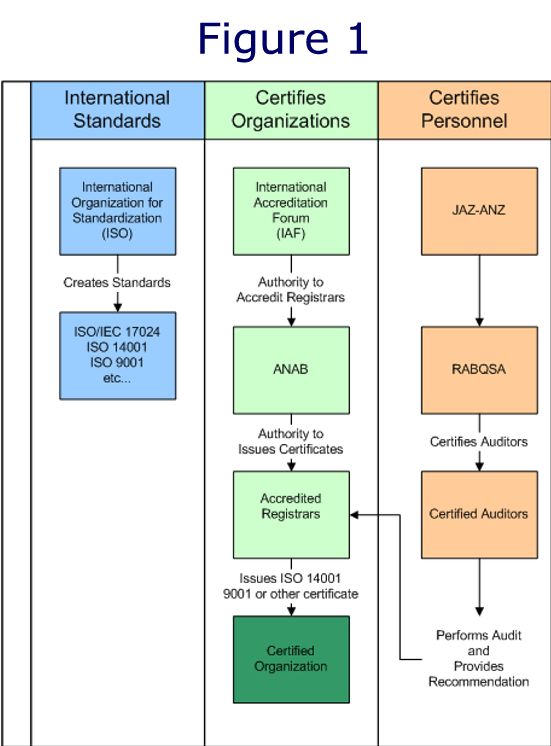The process of becoming registered to ISO 14001 can be confusing. Common questions we are asked include the following:
– Who is qualified to issue ISO 14001 Registration Certificates?
– Who is qualified to perform the registration audits?
– How long is a certificate good and what is the registration process?
These are a few common questions asked by organizations considering implementing an EMS which will be explained here.
What Organizations are Qualified to Issue ISO 14001 Certifications?
Authority to issue internationally recognized ISO 14001 certificates are linked to the International Accreditation Forum. The International Accreditation Forum, Inc. (IAF) is the world association of Conformity Assessment Accreditation Bodies and other bodies interested in conformity assessment in the fields of management systems, products, services, personnel and other similar programs of conformity assessment. Its primary function is to develop a single worldwide program of conformity assessment which reduces risk for a business and its customers by assuring them that accredited certificates may be relied upon. IAF members accredit certification or registration bodies that issue certificates attesting that an organization’s management, products or personnel comply with a specified standard (called conformity assessment).
In the United States ANAB is the main accrediting body for the registrars who actually issue the ISO 14001 Certificates. ANAB is a member of the International Accreditation Forum and a signatory of the IAF multilateral cooperative arrangements (MLAs) for QMS and EMS. Through the IAF MLAs and the Multilateral Cooperative Accreditation Arrangement, ANAB cooperates with other accreditation bodies around the world to provide value to its accredited CBs and their clients, ensuring that accredited certificates are recognized nationally and internationally. The global conformity assessment system ensures confidence and reduces risk for customers engaging in trade worldwide.
At last count ANAB had accredited 45 organizations (28 located in the USA) to issue ISO 14001 registration Certificates.
Registrars have been accredited to issue ISO 14001 certificates by ANAB. ANAB evaluates each registrar against the requirements ISO/IEC 17021 Conformity Assessment – Requirements for Bodies Providing Audit and Certification of Management Systems when determining if the registar should be authorized to issue ISO 14001 Certificates. Accredited registrars hire competent auditors to perform the registration audits and provide a record of the evidence reviewed as part of the auditor’s recommendation for or against registration of the organizations being audited.
Which Individuals are Qualified to Perform ISO 14001 Registration Audits for Registrars?
One of the requirements of ISO 17021 which must be met by all registrars is that the auditors performing audits on behalf of the registrar are competent to do so.
7.2.5 The certification body shall have a process to achieve and demonstrate effective auditing skills, including the use of auditors and audit team leaders possessing generic auditing skills and knowledge, as well as skills and knowledge appropriate for auditing in specific technical areas. This process shall be defined in documented requirements drawn up in accordance with the relevant guidance provided in ISO 19011.
ISO 19011 is specific guidance for registrars on how to establish audit programs and determine auditor competence.
Auditors can demonstrate they have achieved a level competence through personal certification by RABQSA International which is itself accredited by JAZ-ANZ. However, this certification alone is not sufficient evidence to ANAB that auditors working for registrars are competent to perform audits. In addition the registrar must, at a minimum observe the auditor’s performance during an actual audit before they are deemed competent by the registrar.
Figure 1 shows the links between the various organizations making up the registration process.

How is the ISO 14001 Registration Process Performed?
ISO 14001 Certificates are good for a period of three years assuming the organization successfully completes a series of surveillance audits during that three year period. The registration process begins with a documentation review performed by the auditor to determine if the organization has addressed all the elements of the ISO 14001 Standard. The outcome of the document review can be a recommendation by the auditor to proceed to the registration audit process or a recommendation to delay the registration process until the organization has addressed deficiencies identified by the auditor during the Document Review.
The registration audit begins with what is often referred to as a Stage 1 assessment. The lead auditor visits the site for a day or so to review the organization’s environmental aspects and verify conformance with some of the basic ISO 14001 requirements that could not be verified during the Document Review. The purpose of the Stage 1 audit is also to provide the auditor with additional information about the facility to enable them to prepare a plan for the Stage 2 assessment. The Stage 1 audit is also is a final check on the readiness of the organizations to undergo the Stage 2 Assessment.
The Stage 2 assessment is of longer duration (several auditors on site for several days) than the Stage 1 assessment this is a deeper drilling into the organization’s EMS that is performed in either the Document Review or the Stage 1 Assessment. The Stage 2 Assessment is where the audit team collects and records the evidence of the organization’s conformance to the requirements of ISO 14001 and the organization’s own EMS. This is the evidence that the audit team will submit to the registrar supporting their recommendation for registration.
Successful completion of the registration audit begins three year period that the ISO 14001 certificate is valid. During that three year period the registrar will perform periodic surveillance audits (at least once per year) to confirm that the EMS has sustained effectiveness in the ability of the organization to continually improve its environmental performance. At the end of the three year period the re-registration assessment is performed which is of similar duration and scope to the original registration audit.
